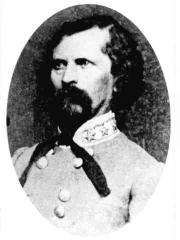Earl Van Dorn
Born in Port Gibson, Mississippi on September 20, 1820, Van Dorn was appointed to West Point by President Andrew Jackson, a distant cousin. While he performed well in non-academic areas, when he graduated in 1842, he was 52nd in a class of 56. His classmates included James Longstreet, who graduated 54th, and William Rosecrans.
He served in the Mexican War, and was breveted twice for gallantry. During the late 1850s, he was a Company Commander in the 2nd U.S. Cavalry, formed by Congress in 1855 to secure the southwester frontier against the Indians. In October of 1858, he participated in a campaign against a combined Kiowa-Comanche gathering near Wichita Village in the territory of Kansas, and was shot through the arm, stomach, and lung.
Praised for his performance against a force twice the size of his own, he was back on the job only a few months later, engaging the Comanches along the Cimarron River in the spring of 1859 . .
By 1861, he had attained the rank of Major in the 2nd U.S. Cavalry, whose field officers include himself, Colonel Albert Sydney Johnston, Lieutenant Colonel Robert E. Lee, and Major George Thomas.
As the South began moving toward secession, Van Dorn was a voice for action. Resigning his commission in the U.S. Army, he was commissioned as a Brig. General in the Confederate Army, second in command of state troops under Major General Jefferson Davis.
When his superior officer was elected to the Presidency of the Confederate States of America, Van Dorn replaced him, and was given the rank of Major General of Mississippi troops.
When General Albert Johnston called upon Van Dorn to join the Army of Tennessee in Corinth to prevent a Union advance, Van Dorn elected first to try to defend against an invasion of Arkansas by troops under the command of Union General Samuel Curtis.
On March 7, 1862, on a peak near Elk Horn Tavern, Van Dorn and General Price clashed with the Union forces at Pea Ridge. While Van Dorn, with troops numbering 16,000, had numerical superiority, poor communication and divided forces caused Van Dorn to lose access to supplies, including ammunition, forcing a retreat with heavy Confederate losses.
Van Dorn himself suffered from cold and chills, after his boat capsized in an icy river during his retreat.
He received orders, which he obeyed, to continue to Corinth, but arrived too late to participate in the Battle of Shiloh.
While he was absolved of responsibility for the Confederate defeat at Corinth, it remained a blot on his record.
Assigned to the river defenses at Vicksburg, he was credited with improving these defenses considerably.
Next, he was assigned to work closely with General Price as Commander of the Army of the West. In another confusion of orders, Van Dorn chose to follow his own instincts and attacked his old West Point classmate, Union General Rosecrans, in the fortifications at Corinth, which he had helped construct before the Union had taken it in early summer.
The result was another Confederate disaster. Van Dorn and Price failed in their frontal assaults against Corinth, while Bragg was having problems in Tennessee.
A Confederate court of inquiry found negligence on his part for his role in the battle, and he was reassigned to the Cavalry. He joined Nathan Bedford Forrest, John Morgan, and Joe Wheeler in harassing the Union troops at every opportunity.
In December of 1862, his small command handed Union General Grant an important defeat at Holly Springs that was a factor in delaying a Union offensive against Vicksburg.
On May 7, 1863, Van Dorn was killed, not in battle, but at the hands of a local doctor, who claimed that Van Dorn had violated the sanctity of his marriage. Others claimed that the doctor had political motivations, having to do with his support of the Union.
|

